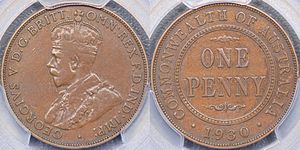Penny (Australian coin) facts for kids
The Australian penny was a special coin used in Australia a long time ago, before 1966. It was part of the old money system called the £sd system. Imagine it like this: one Australian penny was worth a small part of a shilling or an Australian pound.
This coin was first made in 1911. The very last pennies were made in 1964. In 1966, Australia changed its money system to decimalisation, which uses dollars and cents, just like today. After this change, one old penny was worth about 0.8333 cents.
The front side of the penny always showed the picture of the King or Queen of Australia at that time. Three different rulers were on the pennies: George V, George VI, and Elizabeth II. Most pennies with King George VI and Queen Elizabeth II had a cool picture of a Kangaroo on the back. This kangaroo design was also on the Australian half penny and is still seen on the dollar coin today!
Sometimes, you can tell where a penny was made by looking closely. Pennies made in Perth during King George VI's time had a small dot in different places, like near the word "PENNY" or "AUSTRALIA". Coins from Melbourne didn't have these dots. If you saw an "I" under King George VI's picture, it meant the coin was made in India. This only happened for pennies from 1942 and 1943. A "PL" mark after "PENNY" meant it was made in London, England, but only for the 1951 pennies.
Different Penny Designs
The Australian penny changed its look a few times over the years. The main changes were the picture of the ruler on the front and the design on the back. Here's a quick look at the different types:
| Image | Years | Description / Designer | ||||
|---|---|---|---|---|---|---|
| Obverse (Front) | Reverse (Back) | From | To | Ruler on Front | Back Design | |
 |
 |
1911 | 1936 | King George V by Bertram Mackennal |
"ONE PENNY COMMONWEALTH OF AUSTRALIA" by W.H.J. Blakemore |
|
 |
 |
1938 | 1948 | King George VI by Thomas Hugh Paget |
Kangaroo / Commonwealth Star "AUSTRALIA PENNY" by George Kruger Gray |
|
 |
1949 | 1952 | King George VI by Thomas Hugh Paget |
(Same Kangaroo design as above) | ||
 |
1953 | 1955 | Queen Elizabeth II by Mary Gillick |
(Same Kangaroo design as above) | ||
 |
1959 | 1964 | Queen Elizabeth II by Mary Gillick |
Kangaroo "AUSTRALIA PENNY" by George Kruger Gray |
||
Rare and Special Pennies
The 1930 penny is one of the most famous and rare Australian coins! Very few of them were ever made. This makes it super valuable to coin collectors. A 1930 penny in good condition can be worth over A$45,000! It's even known as the most valuable copper penny in the world.
A coin collector named Fritz Schaefer first found a 1930 penny between 1940 and 1944. Since then, it has been Australia's most well-known rare coin.
Other pennies that are hard to find include those from 1925 and 1946. While they are not as valuable as the 1930 penny, they can still be worth a good amount of money to collectors.
There are also special versions of Australian pennies called "varieties." These happened because of different events or changes in how the coins were made. For example, some 1931 pennies are special because the Melbourne Mint was trying out new ways to make coins during the Great Depression.
Another example is the 1920 pennies. Some of these are unique because coin-making tools were moved from the Melbourne Mint to the Sydney Mint. This led to some experimental coins being made before Sydney Mint officially started making pennies. Also, in 1952, the Perth Mint began making its own pennies, which also created some special varieties.
While many penny varieties are common, some are extremely rare and valuable. These include the 1930 English obverse penny and the 1920 English obverse penny with a dot above the bottom scroll.


